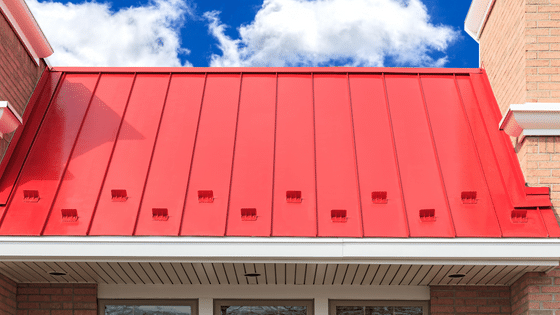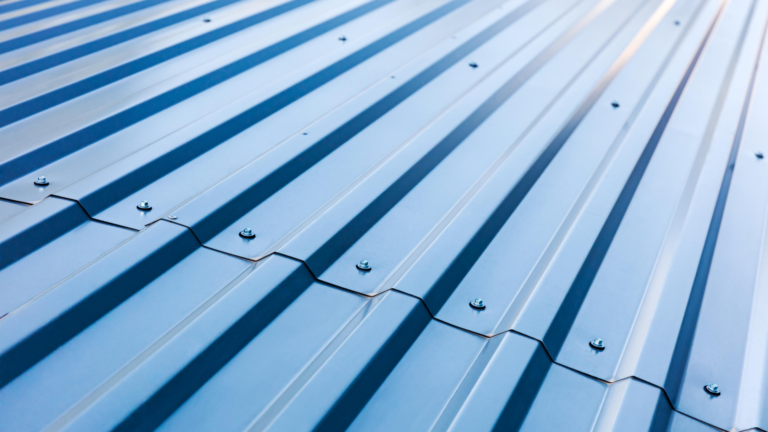Kloeckner Metals supplies galvalume steel which combines the durable properties of aluminum, silicon, and zinc to provide outstanding rust resistance.

| Grades | Size Range | |||
|---|---|---|---|---|
| Gauge | Width | Length | ||
| CS-A | 14 Ga. - 30 Ga. | 36" - 72" | 96" - 120" | |
| CS-B | 14 Ga. - 30 Ga. | 36" - 72" | 96" - 120" | |
| Grade 50 | 14 Ga. - 30 Ga. | 36" - 72" | 96" - 120" | |
| Grades 80 | 14 Ga. - 30 Ga. | 36" - 72" | 96" - 120" | |

Galvalume adds a protective coating to steel sheet. Combining aluminum, silicon, and zinc, galvalume provides outstanding rust protection. Galvalume metal roofing and metal paneling are two of the most common building products for galvalume metal, but it can also be used in other outdoor applications. Whatever the outdoor environment, galvalume metal shows superior resistance to corrosion than standard galvanized steel. It also resists corrosion when exposed to snow, ice, and rain. In effect, galvalume increases both the durability and longevity.
Kloeckner Metals supplies galvalume grades CS-A, CS-B, grade 50 and grade 80. CS Type A and CS Type B are both commercial steels with a carbon, phosphorous, manganese, sulphur, and iron chemical composition. G50 and G80 are both zinc-coated on both sides. These two grades are the most popular galvalume metals for building products. The numbers 50 and 80 reference the zinc coating weight using the unit ounces per square foot (oz/ft2). Of these two galvalume metal grades, grade 80 provides enhanced corrosion resistance.
Advantages:
Resistance to corrosion is the main advantage of galvalume metal. Its signature, high performing zinc-aluminum-silicon coating holds up in rain, ice, snow and where high temperatures are common, surpassing the protection provided by galvanized and galvannealed metal. Galvalume metal roofing and galvalume metal paneling are best suited for industrial and residential applications.
Disadvantages:
Galvalume metal roofing should not be used in coastal environments, high contact environments with animals or animal waste, and it should not be placed in or near concrete, copper, bricks, or treated lumber which might cause galvanic corrosion. Consequently, when selecting galvalume for your metal roofing it’s recommended that you ensure material compatibility with any surrounding components.
Gavalume metal is popular across industries. It’s a top choice for metal roofing due to the strength and protection. You’ll also see it used in the architectural industry, and in general construction for commercial and residential projects. You may also see it used in the agricultural industry.
The main applications for galvalume metal include galvalume metal roofing and paneling. Galvalume is often used in architectural projects, commercial buildings, residential projects, structural or industrial applications, and can be used to accent roofing, pavilions, mailboxes, appliances, and solar trays.
Galvalume steel is able to be machined. It’s possible that a lighter gauge will benefit applications requiring more bending and forming.
Galvalume can be welded. It’s typically recommended that you follow the same precautions as when welding galvanized steel. Welding through the zinc coating can produce fumes that require specific personal protective gear.
Heat treatment is not recommended for galvalume steel.
Advantages:
Resistance to corrosion is the main advantage of galvalume metal. Its signature, high performing zinc-aluminum-silicon coating holds up in rain, ice, snow and where high temperatures are common, surpassing the protection provided by galvanized and galvannealed metal. Galvalume metal roofing and galvalume metal paneling are best suited for industrial and residential applications.
Disadvantages:
Galvalume metal roofing should not be used in coastal environments, high contact environments with animals or animal waste, and it should not be placed in or near concrete, copper, bricks, or treated lumber which might cause galvanic corrosion. Consequently, when selecting galvalume for your metal roofing it’s recommended that you ensure material compatibility with any surrounding components.
Gavalume metal is popular across industries. It’s a top choice for metal roofing due to the strength and protection. You’ll also see it used in the architectural industry, and in general construction for commercial and residential projects. You may also see it used in the agricultural industry.
The main applications for galvalume metal include galvalume metal roofing and paneling. Galvalume is often used in architectural projects, commercial buildings, residential projects, structural or industrial applications, and can be used to accent roofing, pavilions, mailboxes, appliances, and solar trays.
Galvalume steel is able to be machined. It’s possible that a lighter gauge will benefit applications requiring more bending and forming.
Galvalume can be welded. It’s typically recommended that you follow the same precautions as when welding galvanized steel. Welding through the zinc coating can produce fumes that require specific personal protective gear.
Heat treatment is not recommended for galvalume steel.
The “CS” refers to commercial steel. The letter A refers to the specific type of commercial steel. Type A and Type B differ slightly in their chemical and mechanical properties. Both have a makeup that includes carbon, manganese, phosphorus, and sulphur.
“CS” indicates commercial steel, and the following letter refers to the specific type of commercial steel. These two commercial steels have slight variations in their chemical and mechanical properties. However, they share a makeup of the same primary chemical components, which include carbon, manganese, phosphorus, and sulphur.
Double-sided zinc coated G50 steel is a popular choice for building products. It has a zinc coating weight of 50 ounces per square foot (oz/ft2). When compared to Grade 80, this galvalume metal grade offers slightly less protection from rust.
Double-sided zinc coated G50 steel is a popular choice for building products. It has a zinc coating weight of 80 ounces per square foot (oz/ft2). When compared to Grade 50, this galvalume metal grade offers slightly better protection from rust.
The “CS” refers to commercial steel. The letter A refers to the specific type of commercial steel. Type A and Type B differ slightly in their chemical and mechanical properties. Both have a makeup that includes carbon, manganese, phosphorus, and sulphur.
“CS” indicates commercial steel, and the following letter refers to the specific type of commercial steel. These two commercial steels have slight variations in their chemical and mechanical properties. However, they share a makeup of the same primary chemical components, which include carbon, manganese, phosphorus, and sulphur.
Double-sided zinc coated G50 steel is a popular choice for building products. It has a zinc coating weight of 50 ounces per square foot (oz/ft2). When compared to Grade 80, this galvalume metal grade offers slightly less protection from rust.
Double-sided zinc coated G50 steel is a popular choice for building products. It has a zinc coating weight of 80 ounces per square foot (oz/ft2). When compared to Grade 50, this galvalume metal grade offers slightly better protection from rust.
ANSWER:
Galvalume metal roofing offers two main benefits. Where other building product materials might experience typical edge creep, galvalume building products shows self-mending properties which stop edge creep and lower the risk of roof failure. Additionally, galvalume metal roofing is a tougher and more tolerant material.
ANSWER:
The difference between these two metal products is the type of coating. Galvanized steel offers a protective zinc coating. Galvalume metal offers superior protection with percentages of silicon and aluminum in addition to that zinc coating.
ANSWER:
Galvalume is available in various colors. Check out our colors simulator to assess and imagine all the colorful possibilities.
ANSWER:
Galvalume metal roofing offers two main benefits. Where other building product materials might experience typical edge creep, galvalume building products shows self-mending properties which stop edge creep and lower the risk of roof failure. Additionally, galvalume metal roofing is a tougher and more tolerant material.
ANSWER:
The difference between these two metal products is the type of coating. Galvanized steel offers a protective zinc coating. Galvalume metal offers superior protection with percentages of silicon and aluminum in addition to that zinc coating.
ANSWER:
Galvalume is available in various colors. Check out our colors simulator to assess and imagine all the colorful possibilities.
Steel base plates are fundamental elements employed in various manufacturing processes. These flat, rectangular...
Metal fabrication is a critical process that transforms raw metal materials into finished products....
The solar industry has undergone a significant transformation by incorporating steel products into various...
The unprecedented pace of solar growth is challenging and reforming America’s construction and engineering...
If you’ve got a roof over your head, it’s partly thanks to purlins. A...
Acquiring highly profitable company with annual sales of around USD 30 million Significant expansion...
A stainless steel depot is a specialized facility or supplier that stocks and provides...
American manufacturers use about 28.2 billion pounds of aluminum every year, 41.6% of it...
Leading steel distributor expands commitment to sustainability in the North American market. Kloeckner Metals,...
At Kloeckner, we are excited to announce that our Santa Fe Springs, CA location...

X
The Kloeckner Metals website uses modern technologies. Unfortunately, your browser doesn't support those technologies.
Download the latest version of one of these browsers to experience the site: